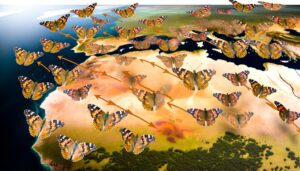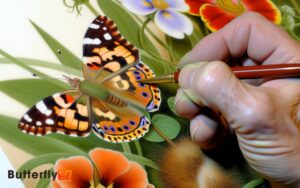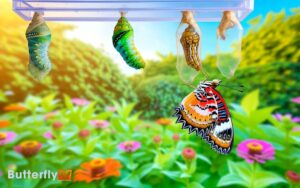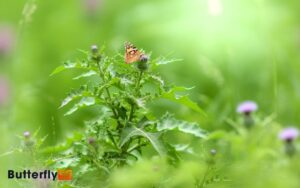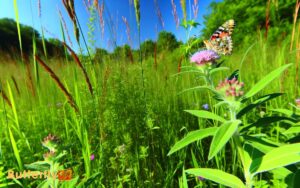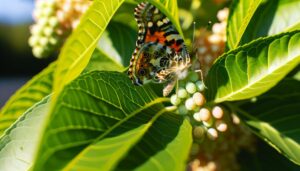Carolina Biological Painted Lady Butterfly: Overview!
The Carolina Biological Painted Lady Butterfly kit provides a detailed study of the butterfly’s life cycle, from egg to adult. It includes a vented plastic cup with nutrient-rich artificial diet and a soft mesh habitat for pupation and emergence.
Observers can watch larvae hatch in 3-5 days, undergo molting phases over 10-14 days, and metamorphose into adult butterflies in 7-10 days. The setup requires a well-lit area, away from direct sunlight, with a shallow water dish.
This hands-on experience enhances comprehension of developmental biology, cell differentiation, and ecological roles. Further exploration will uncover the intricate steps of metamorphosis.
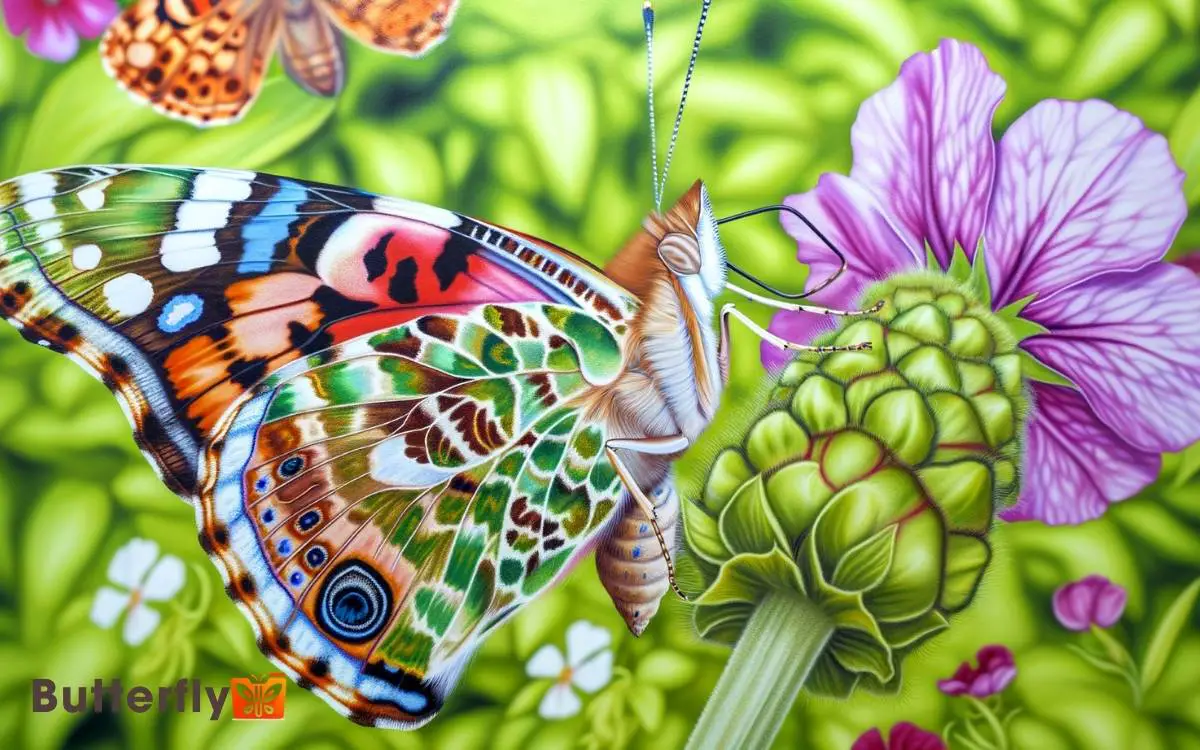
Key Takeaways
Life Cycle Overview
Examining the life cycle of the Painted Lady butterfly, one observes four distinct stages: egg, larva, pupa, and adult. Initially, the female deposits eggs on host plants. Within approximately 3 to 5 days, these eggs hatch into larvae, commonly known as caterpillars.
The larval stage, lasting around 10 to 14 days, involves several instars, or molting phases, where the caterpillar feeds voraciously.
Subsequently, the larva forms a chrysalis, entering the pupal stage. This metamorphic phase, spanning 7 to 10 days, is critical for the transformation into an adult butterfly.
Upon emergence, the adult Painted Lady is characterized by its vibrant orange and black wing patterns. Each stage is essential for the butterfly’s development and successful reproduction.
Kit Components
Understanding the intricate stages of the Painted Lady butterfly’s life cycle underscores the importance of each component included in the Carolina Biological kit.
The kit contains a vented plastic cup with nutrient-rich artificial diet, ensuring larvae receive essential nourishment.
A soft, mesh habitat provides an ideal environment for pupation and emerging butterflies. Also included are an instruction manual detailing care procedures and a magnifying glass for close observation of morphological changes.
The kit’s precision components, such as a brush for safe handling of delicate larvae, reflect the meticulous design aimed at facilitating successful development from larva to adult butterfly.
These elements collectively support educational endeavors by enabling thorough, hands-on exploration of Lepidopteran biology.
Setting Up the Habitat
Setting up the habitat involves carefully arranging the mesh enclosure to guarantee ideal ventilation and accessibility for the Painted Lady butterflies. One must make sure the mesh material is taut to prevent sagging, which could hinder butterfly movement.
The enclosure should be placed in a well-lit area but away from direct sunlight to avoid overheating. A shallow dish with water, containing pebbles to prevent drowning, must be included.
Additionally, artificial nectar sources or sugar-water soaked sponges provide essential nourishment.
Planting host plants, like mallow or thistle, inside the habitat can further replicate natural conditions.
The habitat’s cleanliness is vital; hence, regular maintenance is necessary to remove waste and uneaten food, thereby creating an excellent environment for butterfly development.
Observing Metamorphosis
Witnessing the metamorphosis of Painted Lady butterflies offers an extraordinary opportunity to observe one of nature’s most fascinating biological processes in action. From the initial larval stage, these butterflies undergo significant changes.
The larvae, or caterpillars, consume large amounts of host plant leaves, entering the pupal stage within 7-10 days. During pupation, the caterpillar forms a chrysalis, wherein extensive cellular reorganization occurs.
Adult structures, such as wings and reproductive organs, develop from imaginal discs a process known as histolysis and histogenesis.
Observers might note the gradual darkening of the chrysalis before eclosion, signaling the imminent emergence of the adult butterfly.
Upon eclosion, the adult expands its wings and dries them, completing the metamorphic cycle and readying for the reproductive phase.
Educational Benefits
Observing the metamorphosis of Painted Lady butterflies in an educational setting provides students with a concrete understanding of complex biological processes. This enhances their grasp of developmental biology and ecology.
By witnessing each life stage from egg to larva, pupa, and adult students can directly correlate theoretical knowledge with real-world phenomena.
This hands-on experience fosters critical thinking and observational skills, which are essential in scientific inquiry.
- Developmental Biology: Students learn about cell differentiation, tissue formation, and genetic regulation.
- Ecological Interactions: They understand the butterfly’s role in ecosystems, including pollination and food webs.
- Scientific Methodology: Pupils practice formulating hypotheses, conducting experiments, and analyzing data.
- Such immersive learning experiences cultivate a deeper, more intuitive understanding of life sciences.
Conclusion
To sum up, the Carolina Biological Painted Lady Butterfly kit offers an immersive educational experience, showcasing the butterfly’s life cycle from caterpillar to adult. Students can observe each stage of metamorphosis up close, gaining a deeper appreciation for insect life cycles. The kit also provides insights into the importance of painted lady butterfly host plants, which supply essential nutrients for caterpillars as they grow. This hands-on learning tool is perfect for classrooms or at-home science exploration.
One intriguing statistic reveals that approximately 95% of caterpillars successfully reach adulthood in this controlled environment. This high success rate underscores the kit’s efficacy in facilitating hands-on learning.
By observing metamorphosis firsthand, students gain valuable insights into biological processes, fostering a deeper appreciation for entomology and life sciences.

